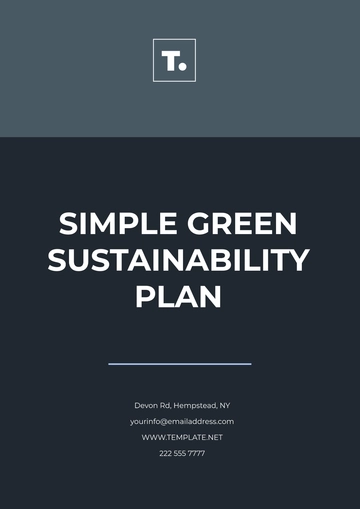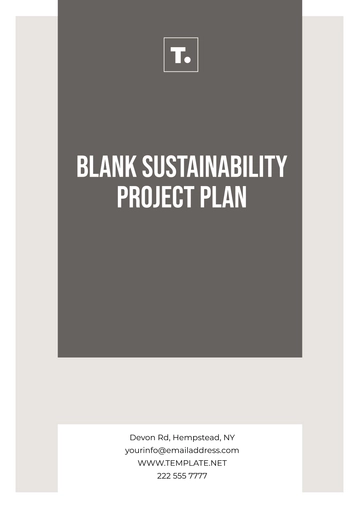Free Administration Environmental Sustainability Plan

I. Introduction
A. Overview
The Environmental Sustainability Plan is a comprehensive strategy designed to mainstream sustainability within [Your Company Name]. This plan is not just about compliance with environmental regulations, but it’s about going a step further to ensure we are doing everything we can to reduce our impact on the environment.
By instituting a range of measures, we aim to minimize the ecological footprint and maximize resource efficiency. This would also align the company with the United Nations Sustainable Development Goals. Our commitment to sustainability is not only beneficial for the environment, but it also makes good business sense. It helps us reduce costs, improve operational efficiency, and enhance our reputation.
B. Goals
Our sustainability goals are ambitious but achievable. They reflect our commitment to environmental stewardship and our desire to lead by example in our industry. Here are our key sustainability goals:
Reduce carbon emission: We plan to achieve this by investing in energy-efficient technologies and optimizing our operations to reduce energy waste. This includes conducting regular audits of our energy usage, identifying areas where we can reduce consumption, and implementing energy-saving measures such as installing energy-efficient lighting and appliances.
Increase energy efficiency: This will be accomplished by upgrading our equipment and facilities to more energy-efficient models and training our staff on energy-saving practices. We will also explore renewable energy options, such as solar or wind power, to further reduce our reliance on non-renewable energy sources.
Ensure a majority of procurement will be green or sustainable products: We will work closely with our suppliers to ensure that the products we purchase are environmentally friendly. This includes prioritizing suppliers who use sustainable manufacturing processes, and choosing products that are durable, reusable, or recyclable.
Active waste reduction initiatives targeting a significant reduction in overall waste: We will implement comprehensive waste management programs, including recycling and composting, to reduce the amount of waste we generate. We will also promote waste reduction among our employees by providing education and resources on how to reduce waste in their daily work.
Implement an effective system for continuous assessment of sustainability efforts: We will regularly monitor and evaluate our sustainability performance to ensure we are on track to meet our goals. This includes conducting regular audits and reviews of our sustainability initiatives, and using the findings to inform our future efforts.
II. Policy Statement
We are committed to promoting an environmentally friendly administrative directive within our institution. This commitment is reflected in every aspect of our operations, from the way we manage our facilities to the products we purchase.
Our commitment to sustainability extends beyond our own operations. We also recognize the importance of influencing our supply chain. This includes the adoption of sustainable procurement practices, where we prioritize suppliers who share our commitment to the environment.
We believe that every member of our organization has a role to play in achieving our sustainability goals. Therefore, we are committed to promoting a green culture among employees. This includes providing regular training and resources to help our staff make more sustainable choices in their day-to-day work.
Finally, we understand that sustainability is a journey, not a destination. Therefore, we have put in place a robust system of monitoring and evaluation. This will allow us to track our progress, identify areas for improvement, and celebrate our successes along the way.
III. Sustainability Plan
A. Energy Efficient Systems
Our commitment to energy efficiency is demonstrated through several key initiatives:
Lighting and Office Electronics: We will install energy-efficient lighting and other office electronics. This includes replacing traditional lighting with LED lights, which use significantly less energy than traditional incandescent bulbs. Additionally, we will upgrade office equipment such as computers, printers, and other appliances to energy-saving models. These upgrades will not only reduce our energy consumption but also result in cost savings in the long run.
Energy Conservation Culture: We will promote a culture of energy conservation within the organization. This includes encouraging employees to turn off lights and electronics when not in use, implementing energy-saving practices in daily operations, and raising awareness about the importance of energy conservation through regular communications and training sessions.
Renewable Energy Sourcing: Renewable energy sourcing will be prioritized. We will explore the feasibility of installing solar panels or wind turbines at our facilities. By harnessing renewable energy sources, we can significantly reduce our carbon footprint and dependence on non-renewable energy sources.
Energy Audits: Regular energy audits will be conducted to identify areas where energy consumption can be reduced and to measure the effectiveness of our energy efficiency initiatives. These audits will provide valuable insights into our energy usage patterns and help us identify opportunities for further improvement.
Employee Engagement: Employees will be educated about the importance of energy efficiency and how their actions can contribute to energy conservation. Regular training sessions will be conducted to equip employees with the knowledge and skills they need to make more sustainable choices in their daily work.
B. Green Procurement
Our green procurement strategy includes the following key components:
Sustainable Suppliers: Our procurement department will source suppliers who advocate for sustainability. This includes evaluating suppliers based on their environmental policies and practices. We will prioritize suppliers who demonstrate a strong commitment to sustainability, use environmentally friendly manufacturing processes, and offer products that are durable, reusable, or recyclable.
Environmentally Friendly Products: We will prefer products that have an extended lifecycle, are produced using environmentally friendly methods, and have minimal packaging. By choosing such products, we can reduce waste and support industries that are committed to sustainability.
Supplier Engagement: We will work closely with our suppliers to encourage them to adopt more sustainable practices. This includes providing feedback and collaborating on initiatives to reduce the environmental impact of their products.
Procurement Policies: We will develop and implement green procurement policies to guide our purchasing decisions. These policies will prioritize sustainability and ensure that it is a key consideration in all procurement activities.
Monitoring and Evaluation: We will monitor and evaluate our green procurement practices to ensure they are effective and to identify areas for improvement. This includes tracking the percentage of green products we purchase and the sustainability practices of our suppliers.
C. Waste Management
Our waste management strategy is focused on reducing waste and promoting recycling:
Recycling Bins: We will install recycle bins in convenient locations around our premises. These bins will be clearly labeled to help employees sort their waste correctly. Regular communications will be sent to employees to remind them about the importance of proper waste sorting and recycling.
Employee Education: We will educate employees about the importance of recycling and how to properly sort their waste. This includes providing information about what can and cannot be recycled, and organizing regular training sessions on waste management.
Compostable Utensils and Containers: Our cafeteria will switch to using compostable utensils and food containers. This will reduce the amount of plastic waste we generate and contribute to a more sustainable food service operation.
Waste Audits: We will conduct regular waste audits to understand what types of waste we are generating and how much of it is being recycled. This will help us identify opportunities to reduce waste and improve our recycling rates.
Waste Reduction Initiatives: We will implement various waste reduction initiatives, such as paperless policies and digital workflows, to further reduce the amount of waste we generate.
D. Staff Training
To promote environmental consciousness within the organization, regular training programs on environmental sustainability will be conducted. This will also include training on proper recycling practices, energy conservation habits, and the importance of buying green products.
Regular Training Programs: We will conduct regular training programs on environmental sustainability. These programs will cover a wide range of topics, including energy conservation, waste management, and green procurement.
Recycling Practices: Employees will be trained on proper recycling practices. This includes understanding what materials can be recycled, how to sort waste correctly, and the importance of recycling to environmental conservation.
Energy Conservation Habits: Employees will be trained on energy conservation habits. This includes turning off lights and electronics when not in use, using energy-efficient appliances, and other energy-saving practices.
Green Products: Employees will be educated about the importance of buying green products. This includes understanding the environmental benefits of green products, how to identify green products, and the role of green procurement in achieving our sustainability goals.
IV. Budget
The budget for our plan is a crucial component that ensures the feasibility and success of our sustainability initiatives. The following chart and table provides a detailed breakdown of our sustainability budget:
Sustainability Initiative | Estimated Cost |
|---|---|
Energy Efficient Systems | $50,000 |
Green Procurement | $30,000 |
Waste Management | $20,000 |
Staff Training | $10,000 |
Total | $110,000 |
Tis budget allocation for our plan is a testament to our commitment to sustainability. It ensures that we have the necessary resources to implement our sustainability initiatives and make a positive impact on the environment. By investing in sustainability, we are not only improving our environmental footprint but also enhancing our operational efficiency, reducing costs, and improving our reputation.
A. Energy Efficient Systems
The budget allocated for energy-efficient systems is $50,000. This will be used for upgrading our lighting and office electronics, promoting an energy conservation culture, and sourcing renewable energy. These investments will not only reduce our environmental impact but also result in long-term cost savings due to reduced energy consumption. The funds will also cover the cost of regular energy audits to measure the effectiveness of our energy efficiency initiatives.
B. Green Procurement
The funds set aside for green procurement, amounting to $30,000, will enable us to source suppliers who advocate for sustainability and prefer products that are environmentally friendly. This will help us reduce waste and support industries committed to sustainability. It also includes the cost of developing and implementing green procurement policies, as well as monitoring and evaluating our green procurement practices.
C. Waste Management
The budget for waste management is $20,000. This will be used for installing recycle bins, educating employees about recycling, and implementing waste reduction initiatives. These efforts will significantly reduce the amount of waste we generate and contribute to a more sustainable work environment. The funds will also cover the cost of regular waste audits to understand what types of waste we are generating and how much of it is being recycled.
D. Staff Training
The budget allocated for staff training is $10,000. This will be used to conduct regular training programs on environmental sustainability. These programs will equip our employees with the knowledge and skills they need to contribute to our sustainability goals. Regular training sessions will be conducted to educate employees about energy efficiency, waste management, and green procurement practices. This investment in our employees is crucial for the success of our sustainability plan.
Overall, this budget is a strategic investment in our future. It demonstrates our commitment to creating a sustainable business that respects and values the environment. This budget allocation is not just about spending money; it’s about investing in a sustainable future for our company, our employees, and our planet. It’s about recognizing that sustainability is not just a moral imperative, but also a business opportunity that can drive growth, innovation, and long-term profitability. By allocating resources to sustainability initiatives, we are positioning our company for success in a world where sustainability is increasingly important. This makes our investment in sustainability a win-win situation.
V. Key Performance Indicators
Key Performance Indicators (KPIs) are a critical part of our plan. The following table outlines our key performance indicators:
Key Performance Indicator | Measure | Target |
|---|---|---|
Carbon Emissions Reduction | Percentage of CO2 reduced | 30% reduction |
Carbon Emissions Reduction measures the percentage of CO2 reduced, with a target of a 30% reduction. This is a critical KPI as it directly relates to one of the main objectives of our sustainability plan, which is to reduce our carbon footprint.
Reducing carbon emissions is not only beneficial for the environment, but it also has several benefits for the company. First, it can result in significant cost savings. By reducing our energy consumption, we can save on energy costs. Second, it can enhance our reputation. Companies that are known for their environmental stewardship often enjoy a positive reputation, which can lead to increased customer loyalty and a competitive advantage in the market. Furthermore, reducing carbon emissions can also help us comply with environmental regulations and avoid potential fines or penalties. It shows our commitment to doing our part in combating climate change, which is a global issue that requires collective action.
The importance of having these KPIs in our sustainability plan cannot be overstated. They provide a clear and measurable way to track our progress towards our sustainability goals. Without them, it would be difficult to determine whether our efforts are effective or if we need to make adjustments to our plan.
Moreover, by regularly reviewing our KPIs, we can identify trends, uncover insights, and make data-driven decisions. This can lead to continuous improvement in our sustainability performance. In conclusion, KPIs are not just a tool for measurement, but a tool for driving the success of our sustainability plan.
VI. Conclusion
In conclusion, this Environmental Sustainability Plan is a testament to [Your Company Name]'s commitment to sustainability. It outlines our strategic approach to reducing our environmental impact, improving operational efficiency, and fostering a culture of sustainability within our organization. This plan is not just about compliance with environmental regulations, but it’s about going a step further to ensure we are doing everything we can to reduce our impact on the environment.
The initiatives outlined in this plan, from energy-efficient systems to green procurement, demonstrate our holistic approach to sustainability. They show that we understand that sustainability is not just about one aspect of our operations, but it’s about how all aspects of our operations interact with each other and with the environment. By implementing this plan, we are making a commitment to continuous improvement in our sustainability performance.
Finally, this plan is not a static document, but a living one. It will evolve and adapt as we learn more about our environmental impact and as new technologies and practices become available. We look forward to the journey ahead and to the positive impact we can make on our environment through the implementation of this plan. We believe that by investing in sustainability, we are investing in the future of our company, our community, and our planet. This makes our investment in sustainability a win-win situation. We are excited about the journey ahead and are committed to making a positive impact on our environment.
- 100% Customizable, free editor
- Access 1 Million+ Templates, photo’s & graphics
- Download or share as a template
- Click and replace photos, graphics, text, backgrounds
- Resize, crop, AI write & more
- Access advanced editor
Establish clear environmental sustainability plans with this editable Administration Environmental Sustainability Plan Template only on Template.net! This customizable document can be easily modified with our AI Editor Tool. It provides a comprehensive guide for environmental sustainability plans, ensuring that your operations are conducted in a sustainable and environmentally friendly manner!
You may also like
- Finance Plan
- Construction Plan
- Sales Plan
- Development Plan
- Career Plan
- Budget Plan
- HR Plan
- Education Plan
- Transition Plan
- Work Plan
- Training Plan
- Communication Plan
- Operation Plan
- Health And Safety Plan
- Strategy Plan
- Professional Development Plan
- Advertising Plan
- Risk Management Plan
- Restaurant Plan
- School Plan
- Nursing Home Patient Care Plan
- Nursing Care Plan
- Plan Event
- Startup Plan
- Social Media Plan
- Staffing Plan
- Annual Plan
- Content Plan
- Payment Plan
- Implementation Plan
- Hotel Plan
- Workout Plan
- Accounting Plan
- Campaign Plan
- Essay Plan
- 30 60 90 Day Plan
- Research Plan
- Recruitment Plan
- 90 Day Plan
- Quarterly Plan
- Emergency Plan
- 5 Year Plan
- Gym Plan
- Personal Plan
- IT and Software Plan
- Treatment Plan
- Real Estate Plan
- Law Firm Plan
- Healthcare Plan
- Improvement Plan
- Media Plan
- 5 Year Business Plan
- Learning Plan
- Marketing Campaign Plan
- Travel Agency Plan
- Cleaning Services Plan
- Interior Design Plan
- Performance Plan
- PR Plan
- Birth Plan
- Life Plan
- SEO Plan
- Disaster Recovery Plan
- Continuity Plan
- Launch Plan
- Legal Plan
- Behavior Plan
- Performance Improvement Plan
- Salon Plan
- Security Plan
- Security Management Plan
- Employee Development Plan
- Quality Plan
- Service Improvement Plan
- Growth Plan
- Incident Response Plan
- Basketball Plan
- Emergency Action Plan
- Product Launch Plan
- Spa Plan
- Employee Training Plan
- Data Analysis Plan
- Employee Action Plan
- Territory Plan
- Audit Plan
- Classroom Plan
- Activity Plan
- Parenting Plan
- Care Plan
- Project Execution Plan
- Exercise Plan
- Internship Plan
- Software Development Plan
- Continuous Improvement Plan
- Leave Plan
- 90 Day Sales Plan
- Advertising Agency Plan
- Employee Transition Plan
- Smart Action Plan
- Workplace Safety Plan
- Behavior Change Plan
- Contingency Plan
- Continuity of Operations Plan
- Health Plan
- Quality Control Plan
- Self Plan
- Sports Development Plan
- Change Management Plan
- Ecommerce Plan
- Personal Financial Plan
- Process Improvement Plan
- 30-60-90 Day Sales Plan
- Crisis Management Plan
- Engagement Plan
- Execution Plan
- Pandemic Plan
- Quality Assurance Plan
- Service Continuity Plan
- Agile Project Plan
- Fundraising Plan
- Job Transition Plan
- Asset Maintenance Plan
- Maintenance Plan
- Software Test Plan
- Staff Training and Development Plan
- 3 Year Plan
- Brand Activation Plan
- Release Plan
- Resource Plan
- Risk Mitigation Plan
- Teacher Plan
- 30 60 90 Day Plan for New Manager
- Food Safety Plan
- Food Truck Plan
- Hiring Plan
- Quality Management Plan
- Wellness Plan
- Behavior Intervention Plan
- Bonus Plan
- Investment Plan
- Maternity Leave Plan
- Pandemic Response Plan
- Succession Planning
- Coaching Plan
- Configuration Management Plan
- Remote Work Plan
- Self Care Plan
- Teaching Plan
- 100-Day Plan
- HACCP Plan
- Student Plan
- Sustainability Plan
- 30 60 90 Day Plan for Interview
- Access Plan
- Site Specific Safety Plan





























